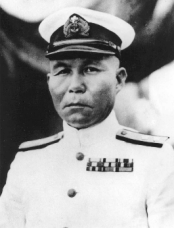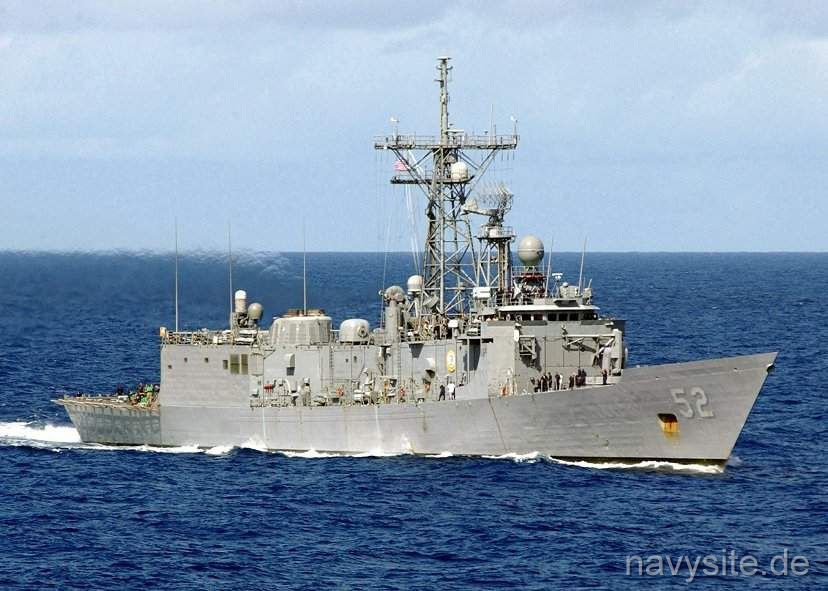|
Posted on 05/30/2003 5:33:25 AM PDT by SAMWolf
|
|
 are acknowledged, affirmed and commemorated.
|

| Our Mission: The FReeper Foxhole is dedicated to Veterans of our Nation's military forces and to others who are affected in their relationships with Veterans. We hope to provide an ongoing source of information about issues and problems that are specific to Veterans and resources that are available to Veterans and their families. In the FReeper Foxhole, Veterans or their family members should feel free to address their specific circumstances or whatever issues concern them in an atmosphere of peace, understanding, brotherhood and support.
|
|
|
|
A Study In Heroism This week, as Canadians and Americans honor our war dead, remember the heros of `Taffy 3:'  At dawn, Vice-Admiral Takeo Kurita's Center Force of four battleships - including the world's largest, mighty `Yamato,' with 18.1 inch guns - 6 heavy cruisers, 2 light cruisers, 11 destroyers, emerged off Samar. Before Kurita lay the entire US invasion fleet, horrifying unprotected: small escort carriers, troop transports, tankers, supply ships. Sink them, and US invasion force would be cut off and destroyed. All that stood between Kurita's capital ships and the beaches was a tiny American escort group: Task Group 77.43, better known as `Taffy 3:' 6 small escort, or `jeep' carriers(each with about 25 aircraft), 3 destroyers(DD), and 3 destroyer escorts(DE's). None had guns larger than 5-inch. Such small shells could not pierce the armor of Japanese battleships or heavy cruisers. As the Japanese bore down on the American ships, the jeep carriers launched their aircraft. Lacking armor-piercing bombs, these planes could only harass the Japanese warships with high- explosive bombs, some torpedoes, and machine-gun fire. Rear Admiral `Ziggy' Sprague issued an immortal order to the six destroyers: `small boys- intercept.'  The DD's and DE's made smoke to mask the carriers. Then, the escorts wheeled, and attacked the advancing Japanese fleet - six unarmored `tins cans' with popguns against the pride of the Imperial Japanese Navy. Not since Sir Richard Grenville took the HMS `Revenge' against the entire Spanish Armada had there been such a gloriously unequal battle at sea. DD-553 `Hoel, Cmdr Leon Kinterberger commanding, led the attack, followed by `Hermann' and `Johnston'. The three escort destroyers - led by `Samuel Roberts,' each with only 2x5-inch guns, followed. At 14,000 yards, the pagoda-masted Japanese battleship `Kongo,' opened fire on `Hoel' with its 14-inch main battery and secondary guns. The rest of the Japanese fleet raked the attacking destroyers, and pounded the fleeing jeep carriers. At 9,000 yards, `Hoel,' her bridge shattered by `Kongo's' 14-inch shells, launched torpedoes. Like nearly all of America's defective torpedoes, they missed. But they forced `Kongo' to turn violently, throwing off her gunnery and sowing confusion in the Japanese formation. Heavy and medium shells riddled `Hoel,' wrecking her port engine, and three of four turrets. Many of the big 14-inch armor-piercing shells passed completely through the thin skins of the unarmored destroyers without exploding.  Undaunted, the shattered, burning `Hoel' attacked a column of enemy heavy cruisers, firing five more torpedoes and her 40mm AA guns. A mortally wounded gunner held his spilling intestines in one hand while he rammed shells into the `Hoel's' last gun with the other. At 0855, after 40 more hits, `Hoel' sank, with 253 of her gallant crew, her battle flags still flying. While `Hoel' lay dying, the other DD's and DE's launched torpedoes at the Japanese battleships and heavy cruisers, charging in close to pepper them at close ranger with 5-inch rounds. The American tins cans were shredded by a storm of Japanese shells ranging from 5-18.1 inch. DD532 `Hermann' furiously attacked heavy cruisers `Haguro' and `Chikuma,' then battleship `Haruna,' then the monster, 71,000-ton `Yamato' with torpedoes, forcing the world's largest battleship to veer out of line. `Hermann's' gunfire, torpedoes, and air attacks from the jeep carriers finally sank cruiser `Chikuma.' Incredibly, `Hermann' survived to sail into Tokyo Bay for Japan's surrender in Sept, 1945.  DE `Johnston' attacked at point-blank range and was sunk. The other American ships were badly damaged. Enemy gunfire sank two of the jeep carriers. But the hopeless, unbelievably brave American attacks so confused and demoralized Adm. Kurita, he broke off the battle and withdrew, snatching defeat from the jaws of victory. Attacks on Kurita's force by US submarines and aircraft in previous days had sunk the admiral's flagship and broken his spirit. Hours before, Adm Jesse Oldendorf's old battleships, raised from the bottom of Pearl Harbor, crossed the enemy T at Surigao Strait, annihilating the second Japanese pincer, sinking two enemy battleships. History's greatest naval battle was won. Without the naval Thermopylae at Samar fought by the `small boys', Leyte would have been a disaster. A few courageous sailors turned it into a triumph that should be taught in every American school for as long as the republic survives. Eternal glory to heros of Taffy-3.
|
I turn into a pumpkin at midnight so watch the clock!

I have your ride ready
 Last dance.
Last dance. Goodnight SAM.




USS GAMBIER BAY (CVE 73) 12-15 June 1944


Japanese plane shot down as it attempted to attack USS Kitkun Bay (CVE-71). Near Mariana Islands. June 1944.

St. Lo

Admiral Takeo Kurita
ERNEST EDWIN EVANS, COMMANDER, U.S. NAVY
Ernest Edwin Evans was born on august 13, 1906, in Pawnee, Oklahoma. He graduated from Central High School in Muskogee, Oklahoma and on May 29, 1926 enlisted in the U.S. Navy. After a year's service as an enlisted man, he was appointed to the U.S. Naval Academy, Annapolis Maryland, from the Navy at large and entered as a Midshipman on June 29, 1927.
Ernest Edwin Evans graduated from the U.S. Naval Academy on June 4, 1931 with the degree of Bachelor of Science and commissioned Ensign in the U.S. Navy. Ernest E. Evans attained the rank of Commander. Ernest E. Evans served in USS COLORADO, USS ROPER, and USS RATHBURNE. Later, Evans joined the USS PENSACOLA. Following service in USS PENSACOLA, continued sea duty and served successively in USS CHAMOUNT, USS CAHOKIA and USS BLACKHAWK.
On August 9, 1941, Evans joined the USS ALDEN, and was serving in that destroyer at the outbreak of World War II in December of that year. Evans assumed command of USS ALDEN on March 14, 1942 and continued as her commanding officer until July y, 1943. Evans was then ordered to duty of fitting out the USS JOHNSTON at the Seattle-Tacoma shipbuilding Corporation, Seattle, Washington. Assuming command of JOHNSTON at her commissioning, 27 October 1943, he commanded her during her entire service.
Commander Ernest E. Evans was in command of USS JOHNSTON on 25 October 1944 during the Battle Off Samar, Philippine Islands. Commander Evans was awarded the Navy Cross, later recalled and replaced by the Medal of Honor, awarded by Congress. The citation which accompanied the Medal of Honor follows;
For conspicuous gallantry and intrepidity at the risk of his life above and beyond the call of duty as Commanding Officer of USS JOHNSTON, in action against major units of the enemy Japanese Fleet during the Battle Off Samar on 25 October 1944. The first to lay smoke screen and to open fire as an enemy task force vastly superior in number, firepower and armor rapidly approached, Commander Evans gallantly diverted the powerful blasts of hostile guns from the lightly armed and armored carriers under his protection, launching the first torpedo attack then the JOHNSTON came under straddling shell fire. Undaunted by damage sustained under the terrific volume of fire, he unhesitatingly joined others of his group to provide fire support during subsequent torpedo attacks against the Japanese and, out-shooting and out-maneuvering the enemy as he consistently interposed his vessel between the hostil Fleet units and our carriers despite the crippling loss of engine power and communications with steering aft, shifted command to the fantail, shouted steering orders through an open hatch to men turning the rudder by hand and battled furiously until the JOHNSTON burning and shuddering from a mortal blow, lay dead in the wter after three hours of fierce combat. Seriously wounded early in the engagement, Commander Evans, by his indomitable courage and brilliant professional skill, aided materially in turning back the enemy during a critical phase of the action. His valiant fighting spirit throughout his historic battle will endure as an inspiration to all who served with him.
In addition to the Congressional Medal of Honor, Commander Evans was entitled to the following medals; Bronze Star, Purple Heart Medal, Presidential Unit Citation Ribbon, China Service Medal, American Defense Service Medal, Fleet Clasp, Asiatic-Pacific Campaign Medal with six engagement stars, the World War II Victory Medal and the Philippine Defense and Liberation Ribbons with one star.
A destroyer escort vessel, the USS EVANS, DE 1023, WAS BUILT IN HONOR OF Commander Ernest E. Evans and was launched on September 14, 1955, in Seattle Washington.

The monument to all 13 ships of TASK UNIT 77.4.3, "TAFFY III, Located at 750 Harbor Boulevard, San Diego, California was dedicated on Wednesday, October 23, 1996 in San Diego
In 1995, the thirteen ships that made up TASK UNIT 77.4.3 began raising funds to erect the monument in downtown San Diego.
Facing the monument, the carriers are listed on the left side and the escort vessels are listed on the right. The ships are listed in accordance with the number of casualties suffered by each ship and are listed as follows:
USS HOEL 252
USS JOHNSTON 183
USS GAMBIER BAY 137
USS SAINT LO 126
USS S. B. ROBERTS 90
USS FANSHAW BAY 40
USS KITKUN BAY 28
USS KALININ BAY 17
USS WHITE PLAINS 13
USS HEERMANN 5
USS DENNIS 4
USS JOHN C. BUTLER 0
USS RAYMOND 0

Disclaimer: Opinions posted on Free Republic are those of the individual posters and do not necessarily represent the opinion of Free Republic or its management. All materials posted herein are protected by copyright law and the exemption for fair use of copyrighted works.